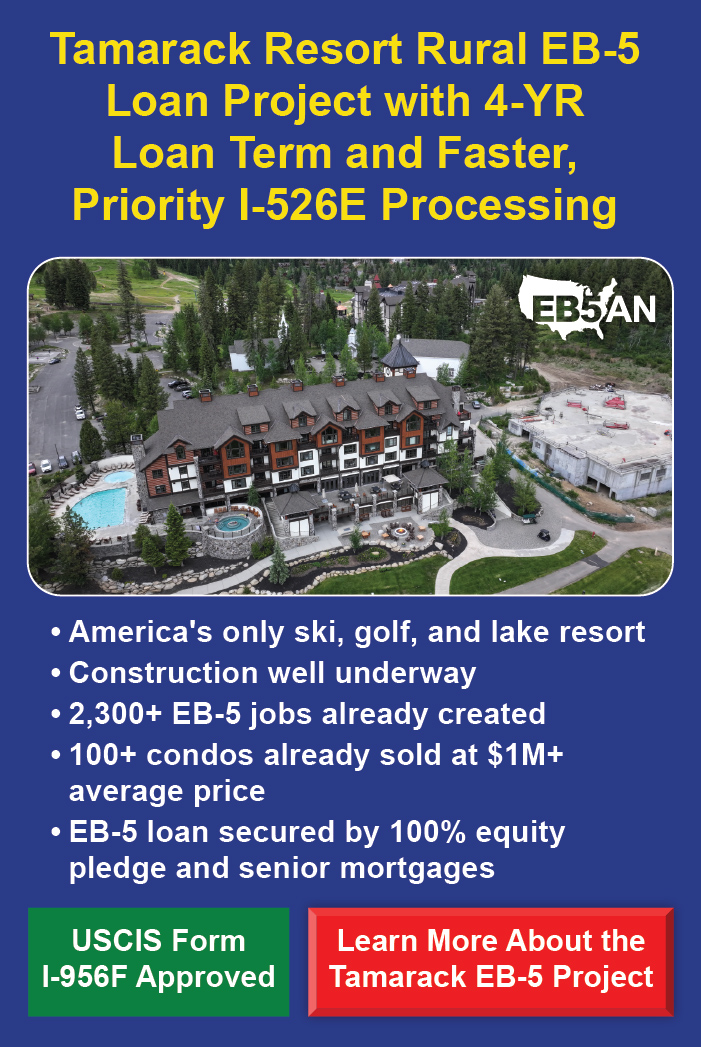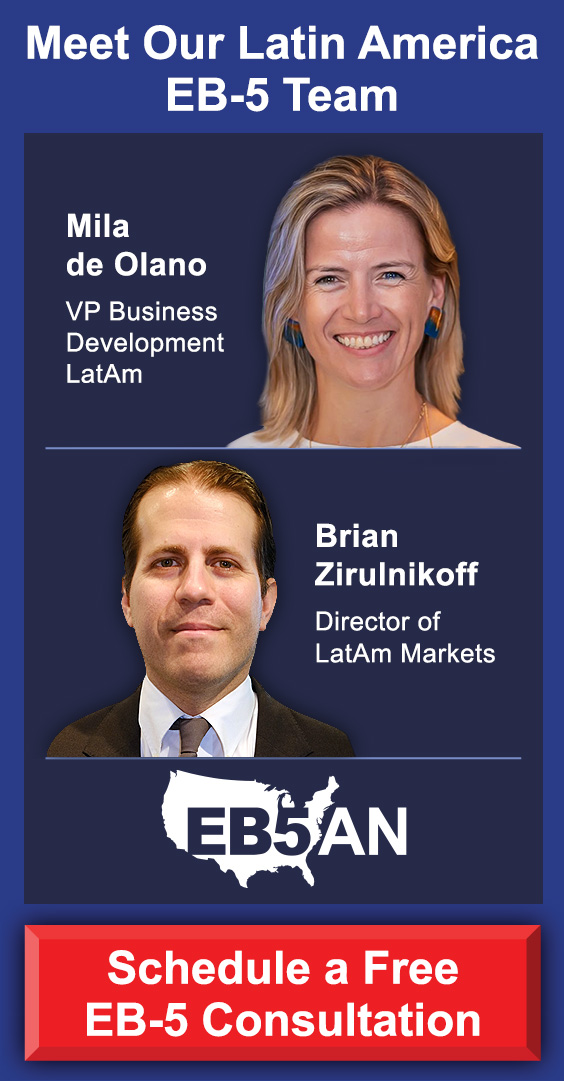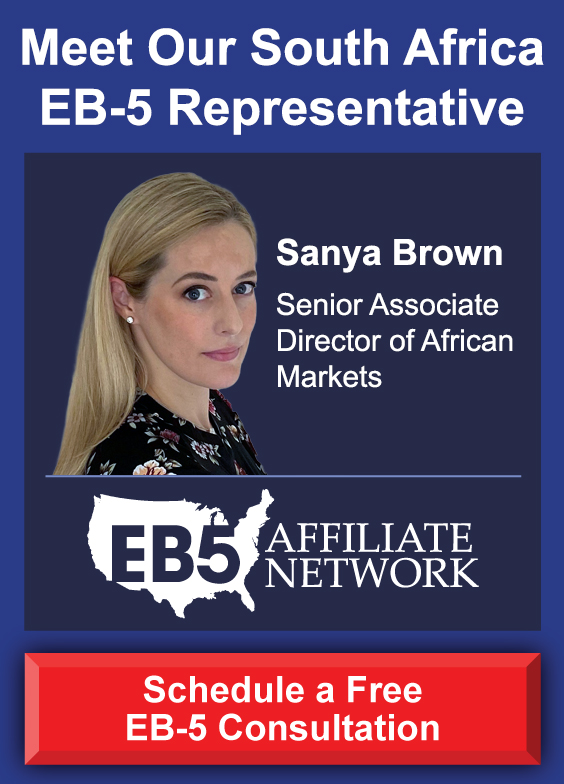What is an EB-5 Regional Center Investment?
The EB-5 Immigrant Investor Program, a permanent federal program established in 1990, allows foreign investors to pursue U.S. residency by investing in a project that creates jobs for American workers. In 1992, Congress created the EB-5 Regional Center Program to simplify the investment process and thus attract more investors to stimulate economic growth. Under the EB-5 regional center program, multiple EB-5 investors can pool their funds together to invest into a single investment that is managed by a USCIS approved EB-5 regional center. The EB-5 regional center program has been re-authorized by the U.S. Congress and will be available to any new investors who invest in EB-5 projects before 2027.
To satisfy the requirements of the EB-5 program, an EB-5 investor must invest either $800K or $1.05M and create at least 10 new full-time jobs for American workers. The minimum investment amounts vary based on the location of the EB-5 investment project: those located in a targeted employment area (TEA) qualify for the reduced investment amount of $800K—all other areas have a minimum investment of $1.05M.
There are two main types of TEA: rural areas and high unemployment urban areas. EB5AN provides both types of investment projects. Below, we’ve listed the latest ones ready for you to invest in.
Invest In A Rural TEA EB-5 Investment Project With EB5AN
There are several benefits to investing in rural EB-5 projects, including:
- Reduced minimum investment—as mentioned above, projects located in a rural TEA require an investment of $800,000 not $1,050,000.
- Priority processing of Form I-526E means faster Green Card approval.
- 20% reserved visa set aside means you’re less likely to get stuck in a visa backlog; especially important if you were born in India or China.
We currently have three options for low-risk rural TEA investments:
Tamarack Resort (Loan)
– $800K Rural Regional Center Investment
Form I-526E and I-956F Exemplar Approved
REGIONAL CENTER EB-5 PROJECT NOW OPEN
- The project is a master-planned all seasons resort with world-class amenities, including a full-service marina on Lake Cascade and an award-winning, operational 18-hole championship golf course ranked #2 in the entire state of Idaho.
- A senior construction loan is already in place, and the project is fully funded.
- The project is in a prime location, only ~20 miles from the McCall Airport and ~100 miles from Boise, Idaho.
- Construction is underway; the mid-mountain lodge was completed in November 2024.
- Over 2,441 eligible EB-5 jobs have already been created as of December 2024.
- Strong sales, with 110+ condominiums already sold at $1M+ average price.
- The project’s rural TEA status qualifies EB-5 investors for faster I-526E processing.
- Multiple investors have already received Form I-526E approvals from USCIS.
- The project’s Form I-956F exemplar application has been approved by USCIS.
- Rural TEA also status means access to the 20% EB-5 visa set-aside category, which reduces investors’ waiting time for a Green Card after their I-526E approval.
- The EB-5 loan is secured with a pledge of 100% equity in the project company as well as senior mortgages on property in Tamarack Resort.
- The project has an exclusive partnership with CoralTree Hospitality, an institutional resort operator and wholly owned subsidiary of legendary real estate company Lowe.
- The project features a short four-year EB-5 loan term.
- EB-5 investors can make partial initial EB-5 investments of less than $800,000 with a commitment to fund the balance within a set period of time.
- EB-5 investors benefit from an I-526E approval refund guaranty.
- EB-5 investors benefit from a job creation guaranty.
- EB5AN’s track record includes 30+ prior EB-5 regional center projects with 100% financial success and USCIS project approval on all prior projects.
- H-1B / F-1 / E-2 / TN / L-1 visa holders can immediately adjust their immigration status and concurrently file for EAD and travel documents.
Rocky River (Loan)
– $800K Rural Regional Center Investment
Prior Fund with Form I-526E and I-956F Exemplar Approval
REGIONAL CENTER EB-5 PROJECT NOW OPEN
- The project is a 1,120 single-family home Cresswind community development being developed by Kolter.
- Kolter is one of the largest private developers in the United States and has invested in real estate projects totaling over $30 billion in value since 1997; Kolter has completed over 100 residential projects, delivered over 27,000 units, and never failed to repay a loan. All EB-5 investments in Kolter projects are in good standing or have been repaid.
- Kolter is one of the top 20 largest private home builders in the United States.
- Follows the success of 13 prior completed and in-process Cresswind communities, with sales to date of 6,500+ homes, 5,800+ of which have been delivered to buyers.
- 350 acres of land acquired for Phase I of the project. Construction began in November 2024.
- The project is expected to create 7,020+ qualifying EB-5 jobs.
- Rural TEA status qualifies EB-5 investors for faster I-526E processing.
- The project’s Form I-956F exemplar application has been approved by USCIS for a prior fund.
- An investor in a prior fund received I-526E approval in only 6.5 months.
- Rural TEA status means access to the 20% EB-5 visa set aside category, which reduces waiting time for a Green Card after I-526E approval.
- EB-5 investors can make partial initial EB-5 investments of less than $800,000, with a commitment to fund the balance within a set period of time.
- Each EB-5 investor’s five-year EB-5 loan term starts on release to the project and is independent from other EB-5 investors’ loan terms.
- The EB-5 loan has a repayment guaranty from a Kolter parent company.
- EB-5 investors benefit from an I-526E approval refund guaranty.
- EB-5 investors benefit from a job creation guaranty.
- EB5AN’s track record includes 30+ prior EB-5 regional center projects with 100% financial success and USCIS project approval on all prior projects.
- H-1B / F-1 / E-2 / TN / L-1 visa holders can immediately adjust immigration status and concurrently file for EAD and travel documents.
Twin Lakes Georgia (Loan)
– $800K Rural Regional Center Investment
Form I-526E and I-956F Exemplar Approved
REGIONAL CENTER EB-5 PROJECT NOW OPEN
- The project is a 1,300 single-family home community development being developed by Kolter.
- Kolter is one of the largest private developers in the United States and has invested in real estate projects totaling over $30 billion in value since 1997; Kolter has completed over 100 residential projects, delivered over 27,000 units, and never failed to repay a loan. All EB-5 investments in Kolter projects are in good standing or have been repaid.
- Kolter is one of the top 20 largest private home builders in the United States and has developed over 29,000 in process and realized homes.
- The project is already profitable with 700+ homes already sold.
- The project has already created thousands of qualifying EB-5 jobs.
- Multiple phases, including the currently open phase of the project have received Form I-956F exemplar approval from USCIS.
- Over 200 Form I-526E approvals received from USCIS across all project funds.
- Rural TEA status qualifies EB-5 investors for faster I-526E processing.
- Rural TEA status means access to the 20% EB-5 visa set aside category, which reduces waiting time for a Green Card after I-526E approval.
- EB-5 investors can make partial initial EB-5 investments of less than $800,000, with a commitment to fund the balance within a set period of time.
- A senior loan agreement is already in place with Third Coast Bank.
- Each EB-5 investor’s five-year EB-5 loan term starts on release to the project and is independent from other EB-5 investors’ loan terms.
- The EB-5 loan has a repayment guaranty from a Kolter parent company.
- EB-5 investors benefit from an I-526E approval refund guaranty.
- EB-5 investors benefit from a job creation guaranty.
- EB5AN’s track record includes 30+ prior EB-5 regional center projects with 100% financial success and USCIS project approval on all prior projects.
- H-1B / F-1 / E-2 / TN / L-1 visa holders can immediately adjust immigration status and concurrently file for EAD and travel documents.
Siena Valley Club (Preferred Equity)
– $800K Rural Regional Center Investment
Form I-956F Exemplar Approved
REGIONAL CENTER EB-5 PROJECT NOW OPEN
- The project is a master-planned all-season resort community with 160 luxury single-family homes, nine lakes with recreational access, an 18-hole Robert Trent Jones Jr. championship golf course, a ski club at Beaver Creek, a lake house, a “cast-off” cabin, and recreational amenities.
- The project is in a prime location in Vail Valley in Colorado near Eagle County Airport and premier ski resorts such as Beaver Creek and Vail.
- The project offers a 4.0% above-market annual preferred return.
- Construction is well underway and over 200 EB-5 jobs have already been created as of December 2024.
- The target investment duration is 4–5 years.
- The project’s rural TEA status qualifies EB-5 investors for faster I-526E processing.
- The project’s Form I-956F exemplar application has been approved by USCIS.
- Rural TEA status also means access to the 20% EB-5 visa set-aside category, which reduces investors’ waiting time for a Green Card after their I-526E approval.
- EB-5 investors can make a partial initial EB-5 investments of less than $800,000 with a commitment to fund the balance within a set period of time.
- EB-5 investors benefit from an I-526E approval refund guaranty, a job creation guaranty, and a construction completion guaranty.
- EB5AN’s track record includes 30+ prior EB-5 regional center projects with 100% financial success and USCIS project approval on all prior projects.
- H-1B / F-1 / E-2 / TN / L-1 visa holders can immediately adjust their immigration status and concurrently file for EAD and travel documents.
Invest In An Urban TEA EB-5 Investment Project With EB5AN
Urban EB-5 projects located in TEAs offer the same investor benefits as those in rural areas. The few main differences are:
- The location qualifies as an urban TEA because the area has at least 150% of the national average unemployment rate.
- Urban TEA EB-5 projects can be larger in scope and can generate higher economic activity because of higher populations in these areas.
- However, investors in an Urban TEA EB-5 project will not receive faster priority processing of their I-526E petitions, and will only have access to a 10% reserved visa set aside
We currently have two EB-5 projects located in urban targeted employment areas:
ONE Tampa (Loan)
– $800K Urban Regional Center Investment
Form I-526E and I-956F Exemplar Approved
REGIONAL CENTER EB-5 PROJECT NOW OPEN
- The project is a 42-story, luxury condominium tower in downtown Tampa, Florida.
- The EB-5 loan has a repayment guaranty from a diversified Kolter parent company.
- The project offers a shorter 3-year loan term, reducing duration of funds at risk.
- The project’s I-956F exemplar application has been approved by USCIS.
- Multiple investors have already received Form I-526E approvals from USCIS.
- Construction is underway; $64M+ already spent.
- Strong sales to date with 111 of 225 total condo units (49.3%) already presold, representing $196M in sales revenue as of April 30, 2025.
- The project enjoys a substantial job surplus with 2,966 total jobs at completion; only 1,000 jobs are needed for 100 EB-5 investors.
- Kolter is one of the largest private developers in the United States and has invested in real estate projects totaling $30B+ in value since 1997; Kolter has completed over 100 residential projects, delivered over 27,000 units, and never failed to repay a loan. All EB-5 investments in Kolter projects are in good standing or have been repaid.
- Kolter has executed a gross maximum price (GMP) contract with Moss & Associates, a national construction management company.
- Urban TEA status means access to set aside visas (available for all countries, which means no visa backlog).
- EB-5 investors can make partial initial EB-5 investments of less than $800,000, with a commitment to fund the balance within a set period of time.
- EB-5 investors benefit from an I-526E approval refund guaranty.
- EB-5 investors benefit from a job creation guaranty.
- EB-5 investors benefit from a construction completion guaranty.
- PRXY Fund Services will serve as a third-party fund administrator.
- EB5AN’s track record includes 30+ prior EB-5 regional center projects with 100% financial success and USCIS project approval on all prior projects.
- H-1B / F-1 / E-2 / TN / L-1 visa holders can immediately adjust immigration status and concurrently file for EAD and travel documents.
Terra Ceia Multifamily (Loan)
– $800K Urban Regional Center Investment
Form I-956F Exemplar Approved
REGIONAL CENTER EB-5 PROJECT NOW OPEN
- The project is a 276-unit market-rate, surface-parked rental apartment community in Palmetto, Florida.
- The EB-5 loan has a repayment guaranty from a diversified Kolter parent.
- The project offers a shorter 3-year loan term, reducing duration of funds at risk.
- The project’s I-956F exemplar application has been approved by USCIS.
- Kolter is one of the largest private developers in the United States and has invested in real estate projects totaling over $30 billion in value since 1997, including 13 completed and in-process multifamily projects; Kolter has completed over 100 residential projects, delivered over 27,000 units, and never failed to repay a loan. All EB-5 investments in Kolter projects are in good standing or have been repaid.
- The project is expected to be operated by Greystar, a leader in property management with over 25,000 team members and over 900,000 units under management.
- The location benefits from Manatee county’s record-setting $2.9 billion budget for infrastructure and community enhancements.
- The area within a 3-mile radius of the property is projected to experience 77% population growth by 2028.
- Urban TEA status means access to set aside visas (available for all countries, which means no visa backlog).
- EB-5 investors can make partial initial EB-5 investments of less than $800,000, with a commitment to fund the balance within a set period of time.
- EB-5 investors benefit from an I-526E approval refund guaranty.
- PRXY Fund Services will serve as a third-party fund administrator.
- EB5AN’s track record includes 30+ prior EB-5 regional center projects with 100% financial success and USCIS project approval on all prior projects.
- H-1B / F-1 / E-2 / TN / L-1 visa holders can immediately adjust immigration status and concurrently file for EAD and travel documents.
Terra Ceia Multifamily (Equity)
– $800K Urban Regional Center Investment
Form I-956F Exemplar Approved
REGIONAL CENTER EB-5 PROJECT NOW OPEN
- The project is a 276-unit market-rate, surface-parked rental apartment community in Palmetto, Florida.
- The project offers a 5.0% annual preferred return.
- The target investment duration is only 3.5 years.
- The project’s I-956F exemplar application has been approved by USCIS.
- Kolter is one of the largest private developers in the United States and has invested in real estate projects totaling over $30 billion in value since 1997, including 13 completed and in-process multifamily projects; Kolter has completed over 100 residential projects, delivered over 27,000 units, and never failed to repay a loan. All EB-5 investments in Kolter projects are in good standing or have been repaid.
- The project is expected to be operated by Greystar, a leader in property management with over 25,000 team members and over 900,000 units under management.
- The location benefits from Manatee county’s record-setting $2.9 billion budget for infrastructure and community enhancements.
- The area within a 3-mile radius of the property is projected to experience 77% population growth by 2028.
- Urban TEA status means access to set aside visas (available for all countries, which means no visa backlog).
- EB-5 investors can make partial initial EB-5 investments of less than $800,000, with a commitment to fund the balance within a set period of time.
- EB-5 investors benefit from an I-526E approval refund guaranty.
- PRXY Fund Services will serve as a third-party fund administrator.
- EB5AN’s track record includes 30+ prior EB-5 regional center projects with 100% financial success and USCIS project approval on all prior projects.
- H-1B / F-1 / E-2 / TN / L-1 visa holders can immediately adjust immigration status and concurrently file for EAD and travel documents.
The History of the EB-5 Regional Center Program
When Congress created the EB-5 program in 1990, EB-5 visa applicants could only make direct investments in new commercial enterprises (NCEs). As detailed below, the lack of an EB-5 regional center sponsor required foreign nationals to create standard, full-time job positions that were registered on the company’s payroll. Moreover, EB-5 visa applicants were devoid of the oversight of a regional center sponsor to manage their funds and ensure that their projects complied with United States Citizenship and Immigration Services EB-5 standards.
These and other limitations of EB-5 direct investment led to the creation of the EB-5 Regional Center Program in 1992. Through this program, business entities can now receive a license from United States Citizenship and Immigration Services (that is, regional center designation) to pool EB-5 funding and supervise its release into a project. While the EB-5 Regional Center Program created an important new niche in the EB-5 industry, regional center sponsorship also grants EB-5 foreign nationals the benefit of increased transparency and accounting requirements for their capital.
With the 2008 financial crisis, regional centers experienced increased demand as project developers across the United States looked to the regional center program as an accessible source of below-market funding. Since then, the regional center program has become by far the most popular investment model in the EB-5 industry.
It is important to note that the regional centers model is temporary and depends on periodic renewal by Congress. While the regional center program had expired briefly due to a delayed spending bill, it experienced a significantly longer period of suspension from June 2021 to March 2022, when the EB-5 Reform and Integrity Act of 2022 was passed. Moreover, due to an initially stringent interpretation of the Reform and Integrity Act, it was not until mid-2022 that regional centers were allowed to resume EB-5 operations.
Now, the regional center model is authorized until September 2027. This secures the regional center EB-5 industry for several more years and incentivizes project developers to raise regional center funding.
The Reform and Integrity Act also introduced stricter transparency and reporting requirements for regional center operators.
Why Are Regional Center Projects Preferable to Direct Investment Projects?
In the direct investment model, an EB-5 investor’s capital is injected directly into an NCE, with no intermediaries. Moreover, direct investment EB-5 projects are only allowed to raise funds from one EB-5 investor, and all 10 required jobs must be standard W-2 positions.
These stricter EB-5 requirements can make it more challenging for an EB-5 investor to fulfill all the immigration services criteria for a Green Card. Many foreign nationals also prefer the additional oversight and transparency that a regional center sponsor can provide; they may be able to seek professional advice from their regional centers managers, who are likely experienced in fund management, accounting, immigration law, and other related fields. Most regional center projects are also located in targeted employment areas.
Regional centers control the flow of EB-5 investment capital into a regional center project. This allows for increased supervision of the transactions, and regional centers can carefully vet the project developer they will collaborate with to ensure financial integrity and compliance with immigration services regulations. Foreign investors who work with regional centers often feel more confident that their funds will be managed carefully and used exclusively for EB-5-compliant job creation purposes.
Perhaps the greatest benefit of EB-5 regional centers is their ability to count indirect employment toward fulfilling the 10-job requirement for investors. Indirect employment is calculated, not by an NCE’s payroll records, but by its overall economic impact. Metrics such as the construction expenditures of a project are used for this purpose.
This framework allows EB-5 investors to reach the 10-job requirement more easily. In some cases, EB-5 visa applicants can invest in regional centers projects that have already created part or all of the needed jobs through construction expenditures. In turn, this can significantly increase an EB-5 investor’s chances of immigration and financial success.






























